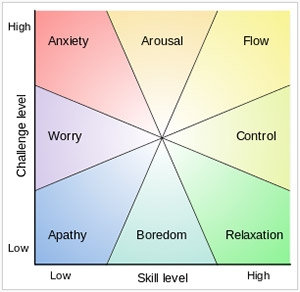I’ve written before in general terms about relaxing into Topspace (or Domspace) and how it feels. Although that was written from a personal point of view, there is a scientific explanation.
A lot has been written about subspace. Topspace is discussed much less. That might be because subspace is more “observable” than topspace, or it could be that the community is more motivated to recognise altered states in bottoms than in tops. Guiding your bottom into subspace is seen as something of a goal for Tops, but we seldom look at the other side of the coin.
WHAT IS FLOW?
In 1991, psychologist Mihály Csíkszentmihályi identified a state that he called “flow”, where a person performing an activity is energised by focus, full involvement and enjoyment in the process. Csíkszentmihályi described the flow experience as one in which “The ego falls away. Time flies. Every action, movement, and thought follows inevitably from the previous one…”
Flow involves challenge and the utilisation of skills, intense concentration, an altered sense of time, the loss of self-consciousness, goals, feedback and the conflation of action with awareness.
 Hopefully you recognise this state. Perhaps you call it “the zone” or something similar. It’s that time when you’re doing the thing you love to do and you’re lost in it. You’re drawing deep into your skills and you’re totally focused on what you’re doing. If you look up at the clock you might notice that an hour has passed and you haven’t even noticed.
Hopefully you recognise this state. Perhaps you call it “the zone” or something similar. It’s that time when you’re doing the thing you love to do and you’re lost in it. You’re drawing deep into your skills and you’re totally focused on what you’re doing. If you look up at the clock you might notice that an hour has passed and you haven’t even noticed.
This optimal experience, Csíkszentmihályi argues, can be generated in activities as varied as playing a musical instrument, running, and performing manual labor. Finding that magical sweet spot is often described by people into extreme sports, like mountain climbing, kayaking and snowboarding, as the reason they do what they do.
There are certain conditions required to get into a flow state. You can’t do it by taking a bath or watching TV, just because you like those things. Csíkszentmihályi’s theory postulates three conditions:
1. The activity has a clear set of goals and progress. This adds direction and structure to the task.
2. The task at hand must have clear and immediate feedback. This helps the person negotiate any changing demands and allows them to adjust their performance to maintain the flow state.
3. There must be a good balance between the perceived challenges of the task at hand and the person’s own perceived skills. They must be confident in their ability.
That last point is very important, and the graph illustration shows how it works.
THE LINK BETWEEN FLOW AND TOPSPACE
Discussion about subspace often includes terms like “flying” or “high”. When you talk to a Top about their altered states, you’re more likely to hear phrases like “in the zone” or “grooving”.
Tops achieve flow through mental focus, particularly when engaged in activities that
require intense concentration. Depending on your skill levels and what you’re into, that might include scenes such as knife play, needle play and advanced bondage, or it could be the meditative rhythm of whipping, flogging or spanking, juxtaposed with the concentration required to do so safely.
Often those who are outsiders or new to BDSM view it as a form of sex and conflate the ecstatic with the erotic. Experienced BDSM practitioners seldom speak of their experiences in that way. Pleasure, for the BDSM Top, is seldom about sexual arousal, erogenous zones or orgasms. They speak of weightlessness: of grooving and flying, of the cessation of cognitive process and of the disappearance of the world around them.
Like extreme sports, for the BDSM Top there is a combination of excitement, or thrills, and flow from the matching of skills with challenge. This thrill-and-flow cycle combines levels of enjoyment that seem alternatively superficial and deep, resulting in a holistic and multilayered sense of pleasure, rebirth and serenity.
FURTHER READING
• Wikipedia – Flow (Psychology)
• Psychology Today – The Surprising Psychology of BDSM
• TED Talks – Mihály Csíkszentmihályi: Flow – The Secret to Happiness

2 Comments Add yours